In a word, “Wow!” Bong Joon-ho’s (whose 2009 film, Mother, was a surprise hit in Asheville) first English language film, Snowpiercer, is near the very top of 2014’s “Best of” list — at least so far, and I can’t imagine it slipping out of the top five, no matter what surprises are in store as the next few months unfold. This incredible, nonstop outpouring of imagination and surprising twists is that rarest of things: The intelligent blockbuster with something on its mind. Or, as one character describes it, “a blockbuster production with a devilishly unpredictable plot.” Yes, the film offers its own assessment of what it is — and most aptly, since the proceedings, motivations and relationships are only slowly — and surprisingly — made clear. In fact, one relationship is made apparent in the film’s last three or four minutes. It is a film of such complexity that it required two viewings for me to feel even slightly comfortable writing about it. That second viewing proved that the film offers hint after hint about some aspects, but those hints are difficult to pick up on till you watch it again. A second look also increases the emotional impact of Snowpiercer, making it clear what an intensely moving — even shattering — experience it is.
Almost as remarkable as the film itself is the fact Bong Joon-ho went head-to-head with Harvey Weinstein, who wanted to cut the movie (what else is new?) and won. In a way, I can understand why Weinstein might have been reticent to release Bong’s cut. It is not an easy film. It will be too dark and violent for some and too politically charged for others. The entire film — save for about a minute — takes place on a fantastic and fantasticated train. The train is, so far as we know, carrying the last remnants of humanity in an endless loop around the world — and has been doing so for 18 years. The world itself has become an uninhabitable frozen wasteland, thanks to an attempt to stop global warming that went wildly wrong. What is left of the human race — and of any life at all — made it onto this train, which has become the world. And it is a world that works as an extension of our own world, with the wealthy few enjoying the benefits, while the rest of society are “kept in their place,” living on scraps and in squalor. No, this is not just my reading of Snowpiercer. The film is very upfront about the oligarchic nature of the society, with its few haves and the many have-nots. The latter are, in fact, called “takers.” (That, and the fact that this society exists on a super train, makes for a tempting reading of the film in terms of Ayn Rand. However, Bong is a Korean filmmaker, and the film is based on a French graphic novel, so this may be coincidental, since the Rand cult is almost entirely American in nature.)
The film’s focus is on a revolt against the ruling class that inhabits the front sections of the train (of course). And — despite the film’s status as political allegory — it’s a compelling, exciting and suspenseful ride. This is never a star vehicle, though both Chris Evans as the (partly by default) leader of the revolt and Song Kang-ho (Sympathy for Mr. Vengeance) as the drug-addled security expert are for all intents and purposes the leads. Plus, the film leans pretty heavily on Tilda Swinton’s nasty bureaucratic villain. (Asking why Ms. Swinton has been in three of the year’s best films would not be out of place.) Mostly, it’s an ensemble piece, and when that ensemble includes Ed Harris, John Hurt, Octavia Spencer, Ewan Bremner and Ko Ah-sung (The Host), it’s in good hands. What is remarkable is the way each performer manages to create the sense of a real character and how much most of the actors make us care about what happens to them — especially, starting at the 50-minute mark when we realize that high billing doesn’t guarantee anyone will make it to the front of the train. That also increases the film’s suspense to no end.
On every level, Snowpiercer is an amazing accomplishment. It is stylish and beautifully photographed from first to last. There’s clearly a touch of Terry Gilliam to the proceedings. For that matter, John Hurt’s name in the film is Gilliam. The film’s ability to turn around on itself in ways that are constantly surprising, yet ultimately make sense in the fabric of the story, is stunning, and things are rarely what they seem. Some may find Bong Joon-ho’s tonal shifts startling, but if you’re familiar with his earlier films, they’re consistent. It is, I suppose, possible to pick the film apart on a realism basis, but traditional realism is so clearly not what the movie is about that it seems a pointless game. It is, in any case, true to the world the film has created. It’s also a film that can be taken as nothing more than a dynamite sci-fi action film, if that suits you, though it’s really about much more. And its allegory may be in-your-face, but its arguments are startlingly complex. I really can’t recommend this one strongly enough. See this film! Rated R for violence, language and drug content.



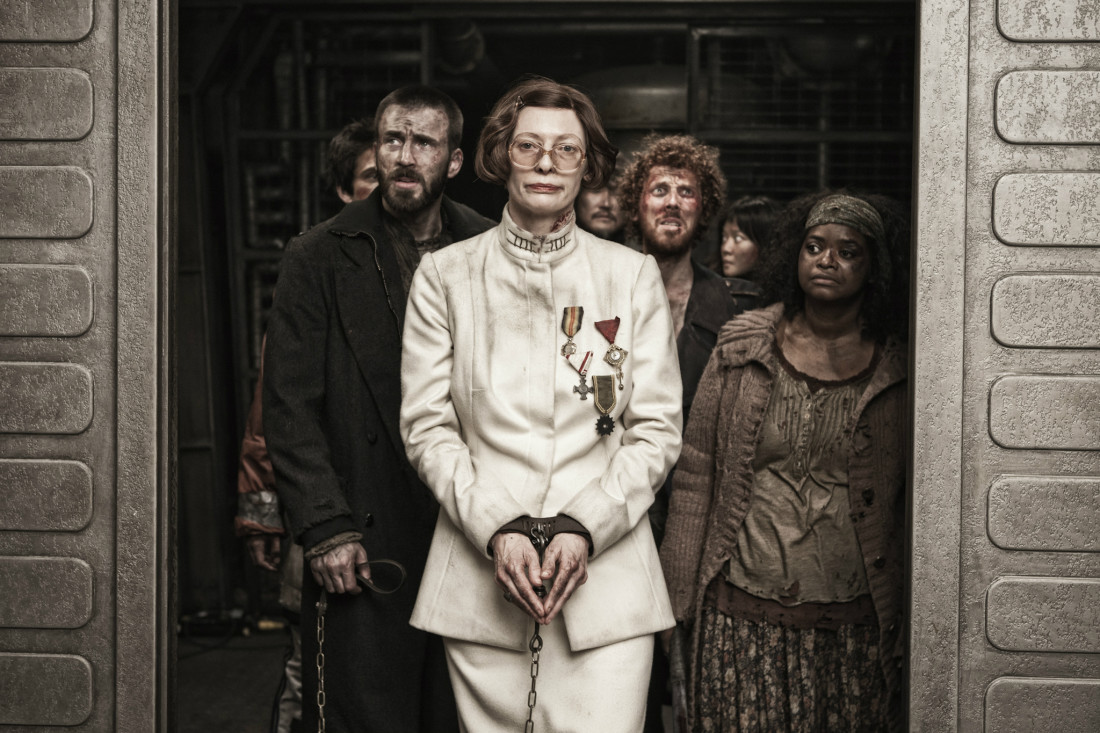
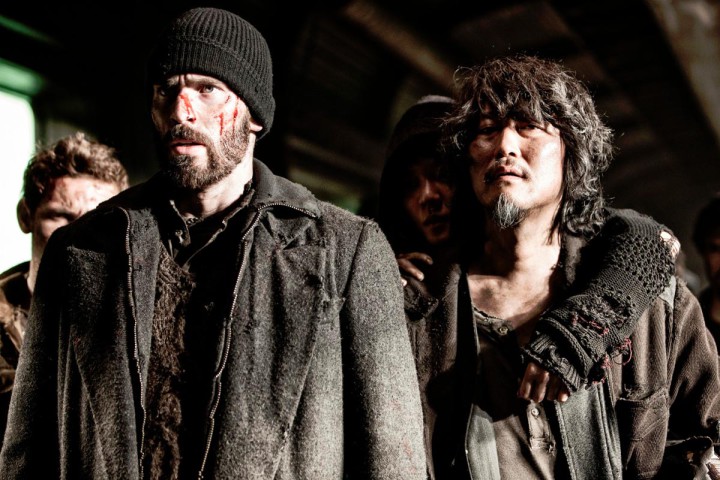
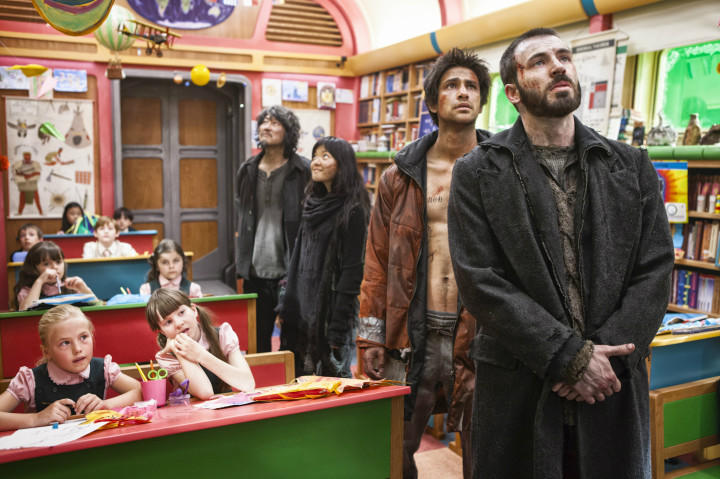
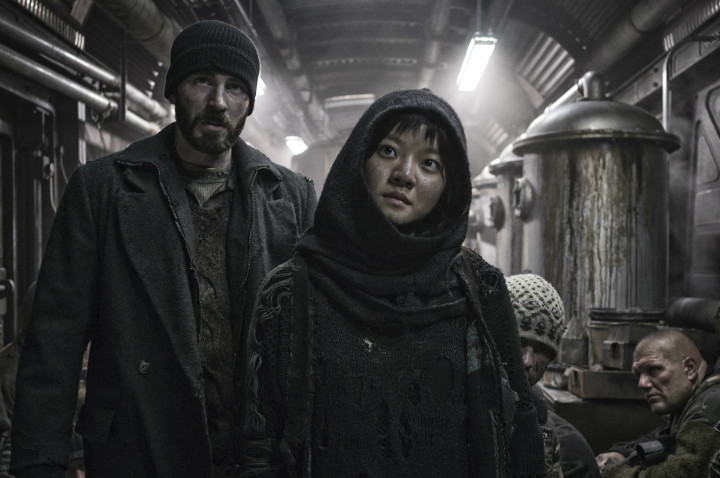
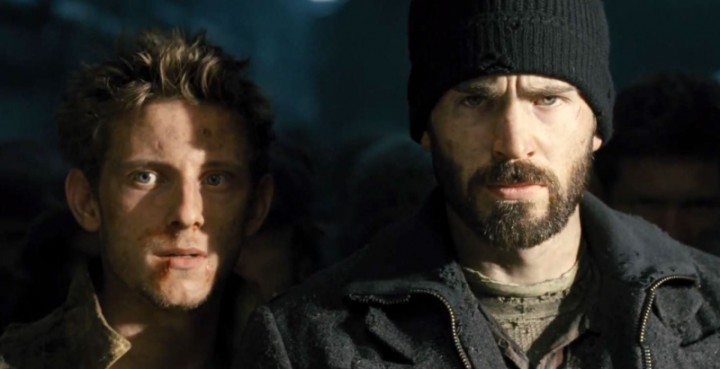
Do you think this film will ever get a wide release? It seems like something that a mass audience could maybe be interested in.
No.
I thought it was excellent and I honestly can’t think of another piece of 21st century science fiction that so expertly balances engaging social and political commentary with such an unshakable aptitude for being really damn entertaining. I am a little worried about how much business it will do here, but the small audience at the Fine Arts Theatre’s first Friday show hopefully won’t be too indicative of its overall performance.
Anyway, Bong’s film ultimately reminded me more of early Jeunet than Gilliam, although I suppose that the distinction there is rather minor. I do know that the sequence that introduces the train’s axe-inclined goon squad unsettled me more than it really should, and I’m really not sure why. Same thing with the stuff in the school car.
Size 10 chaos indeed, and of the most spectacular kind.
Jeunet didn’t occur to me while watching it, but the minute you said that it made sense.
I am hoping that the third-to-half-full theater at The Carolina for the 1:25 show on Friday is a better barometer for its chances here. I think it might be, because it seems to me not a wholly comfortable fit with the Fine Arts core audience.
With all the attention mainstream theaters give to sci fi fanboys, you would think that this would be playing everywhere and making big money.
It’s not aimed at sci-fi fanboys. No one wears spandex for one thing. It’s not tied to some brand-name. It’s strange and cerebral and requires actual thought to follow. If you see the movie, you’ll probably understand why neither Regal, nor Carmike booked it here. (Of course, Carmike couldn’t once the Fine Arts did.) Wondering why this isn’t playing everywhere would be like wondering why Danny Boyle’s Sunshine wasn’t a wide release.
I watched it over the weekend and still don’t see how it couldn’t have been a wide release. Isn’t Chris Evans their boy? Just going by all the online buzz, one would assume the fanboys would go out in droves to see this thing.
The film could benefit from being a little more subtle with its message.
Based on “online buzz,” Snakes on a Plane should have been huge.
Chris Evans isn’t “their boy,” Chris Evans as Captain America is. There’s a difference.
How exactly would the film benefit by being more subtle with its message? It’s not that kind of a movie. It has no interest in being subtle. Why should it? What would it gain?
Well, this did gratifying business at both theaters, so the 1:25 crowd on Friday at The Carolina was not an anomaly.
I have read several critics on this movie and agree with Hanke that it is brilliant in many ways. The allegory seems pretty simple ( I probably have missed some of it) but one dimension of irony has been overlooked by all the reviewers I’ve read: that is that the train provides two solutions to the issues which were leading humanity to Armageddon in the first place: the climate and environmental degredation, on the one hand, and human overpopulation and the slow extinction of species on the other. Jacob Bronowski, in his brilliant “Ascent of Man” noted that science and technology had exacerbated the destructiveness of human nature, but that, ironically, only science can save us. Here science has failed miserably and ushered in the next Ice Age. What “saves” “us’ then? Crazy people, megalomaniacs, trained killers, and an Ubermensch, who has learned to create in the train: 1) a constant temperature and 2)a constant number of humans, apparently just what we needed.
Satisfying, heartening, and altogether affirming news.
And that mention of SUNSHINE made me realize that I might have been a little too, ah, hyperbolic in my placing of SNOWPIERCER on an unassailable peak, as both Boyle’s film and CHILDREN OF MEN are on the same tier and in the same general vein of science-fiction as this movie, in addition to what others I’m certainly forgetting.
Even if we include Sunshine and Children of Men, it’s still a select few.
Ken, did you see this piece over at Flavorwire?
“Will ‘Snowpiercer’s’ VOD Success Change the Film Industry?”
http://flavorwire.com/468183/will-snowpiercers-vod-success-change-the-film-industry/
I would have taken off at least half a star for all the expository dialogue. Show me, don’t tell me.
I can’t say it bothered me.
Really? It always strikes me as a lazy, sophomoric tool. You value it, or see some sophistication in its use? Or just don’t notice it?
I’m still puzzled at how they raised cattle on a train.
I certainly didn’t notice or become otherwise distracted by overly expository elements in the dialogue, but I admit that I consider the film such an endless supply of wonder and horror that I may have simply been too enraptured by it to register those faults. Even so, I doubt that they’ll sway my opinion of the film’s excellence on my second viewing.
And of all the breaks with reality in the movie, I find it strange to take exception with the train’s cattle farming tendencies. Honestly, I’m not sure that growing beef within the confines of a train is all that removed from modern commercial farming practices, although I’m no expert on the matter. Anyway, as Ken mentioned, our precise reality isn’t really relevant to the film’s concerns, nor should it be. If one has to ignore realism for the sake of a fine and effective image, as well as for consistency within a fictionalized universe, so be it. That seems to be a reasonable trade.
I found it odd that they treated the bug/bars vat as a horrific thing. Ok its bugs, its not “made of people!”
So glad I finally saw this. In fact, it was a great day at the movies. I saw this in a double bill with LIFE ITSELF. Both will be high favorites of 2014. I’m looking forward to seeing this a second time and put more pieces together…..SPOILER AHEAD……………SPOILER AHEAD……………A bleak ending too, I’m sure that bear had one thought and that was “ooh, food”.
Maybe, maybe not. After all, it’s been eating something all along or it wouldn’t be alive,
And alive is something this won’t be come Friday. It actually held up pretty good, but room had to be made for those fucking turtles.
I finally caught this. Unfortunately Polar Bears kill and eat everything they see. Those nature shows on Polar Bears generally don’t show that the cameramen are ensconced behind fences with well armed guards on hand so they don’t get eaten. And it is impossible for two people to further the species. The number needed to avoid genetic problems is in the tens of thousands. Like any SciFi movie there are plenty of logic and plot holes. Namely, how can a closed system of humans overpopulate itself several times in only 17 years requiring 74% diebacks? There weren’t that many children aboard.
None of these things are important. This was a very good, entertaining and visually compelling movie.
Well, there is nothing to indicate the distance between these people and the bear, if you want to get technical about it. I think the bear exists in the film not for any sort of peaceful kingdom idea, but because if it’s alive other things have to be alive, since it’s been eating something. I also don’t think these are the only people alive — They may not even be the only people who survived the train wreck. (Also it’s going to be awhile before that boy is going to procreate.)
I don’t suppose you got to see this on the Big Screen. It’s a much more visceral experience that way.
Watching this again two weekends ago, the severity of the train crash and where most of the other compartments end up makes me less confident that others survived.
Yes, I got it that for a polar bear to exist there has to be a pretty extensive ecosystem in place. And the fact that they could survive outside more than a few minutes meant that the Earth was beginning to warm again. I only meant to convey that with such a well done movie I don’t care about some perceived errors one bit.
Unfortunately my family situation currently makes it difficult to get to movies much. But I have a pretty big LED TV available so blu-rays at least allow me to simulate a theater especially with my nice old Sansui 15″ speakers hooked up.